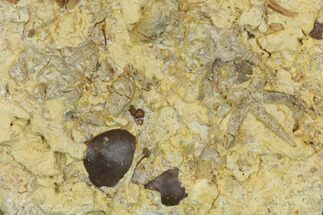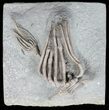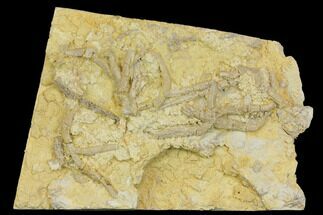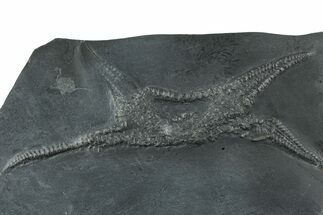This Specimen has been sold.
Spectacular Crinoid & Starfish Association - Crawfordsville, Indiana
This is a spectacular association piece from Crawfordsville, Indiana. Central on the piece is a detailed and very 3d Agaricocrinus americanus. There are two Macrocrinus mundulus associated with it, both with preserved anal tubes. Wrapped around the base of the Agaricocrinus is a rare starfish, Onychaster flexilis. The Agaricocrinus also has some bulges in the arms which are due to parasites.
The Agaricocrinus is 3.2" long and the entire piece measures 5x5" square. The quality of preparation on this fossil is exquisite - using skillful air-abrasion techniques under a stereo microscope. Comes with a display stand.
It is believed that crinoids from the Ramp Creek Limestone were buried in sediment from nearby deltas during storms. The resulting siltstone deposits are soft enough that fossils can be extracted in exquisite, three-dimensional relief.
The Agaricocrinus is 3.2" long and the entire piece measures 5x5" square. The quality of preparation on this fossil is exquisite - using skillful air-abrasion techniques under a stereo microscope. Comes with a display stand.
It is believed that crinoids from the Ramp Creek Limestone were buried in sediment from nearby deltas during storms. The resulting siltstone deposits are soft enough that fossils can be extracted in exquisite, three-dimensional relief.
Crinoids, sometimes commonly referred to as sea lilies, are animals, not plants. They are echinoderms related to starfish, sea urchins, and brittle stars. Many crinoid traits are like other members of their phylum; such traits include tube feet, radial symmetry, a water vascular system, and appendages in multiples of five (pentameral). They first appeared in the Ordovician (488 million years ago) and some species are still alive today.
SPECIES
Agaricocrinus americanus, Macrocrinus mundulus & Onychaster flexilis
LOCATION
Witherspoon Quarry, Crawfordsville, Indiana
FORMATION
Ramp Creek Limestone
SIZE
Agaricocrinus 3.2", Rock 5x5"
CATEGORY
SUB CATEGORY
ITEM
#56459
We guarantee the authenticity of all of our specimens.
 Reviews
Reviews



























